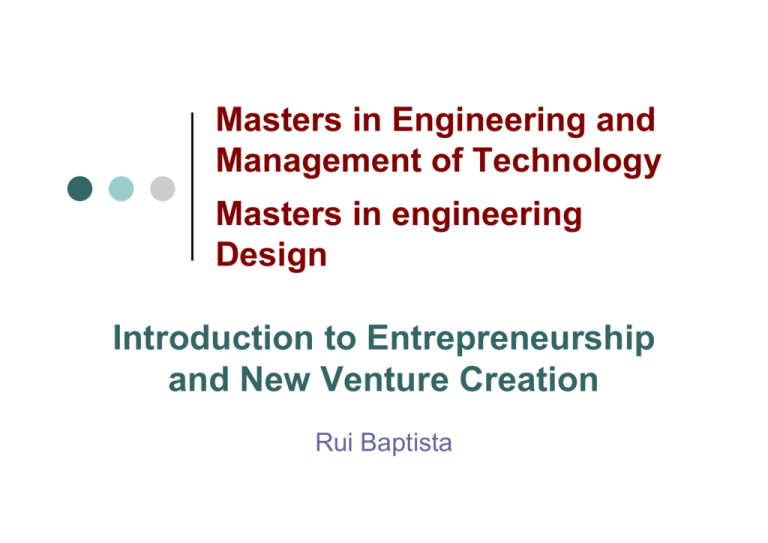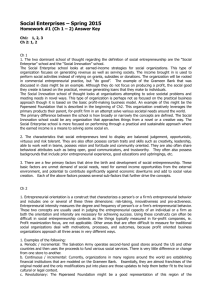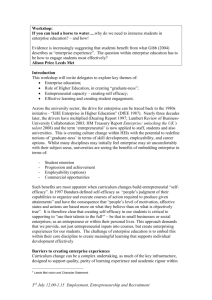The Entrepreneurial Process
advertisement

Masters in Engineering and Management of Technology Masters in engineering Design Introduction to Entrepreneurship and New Venture Creation Rui Baptista Preliminaries Introductions | Course Objectives and Content | Class Schedules and Readings | Deliverables and Student Evaluation | Student Projects | The Entrepreneurial Revolution and the Entrepreneurship Process Entrepreneurship in America Research findings by the U.S. Small Business Administration z Small businesses represent 99 percent of all employers z Small businesses provide about 75 percent of all new net jobs Mega-Entrepreneurs Who Started in Their 20s Microsoft—Bill Gates and Paul Allen | Dell Computers—Michael Dell | Apple Computers—Steve Jobs and Steve Wozniak | Federal Express—Fred Smith | Amazon—Jeff Bezos | Nike—Phil Knight | New Industries Launched by the E-Generation | | | | | | | | | | Personal computers PC software Biotechnology Wireless communications/handheld devices Healthy living products Cellular phone services CD-ROM Internet publishing Internet shopping Virtual imaging Innovation Since World War II | Small entrepreneurial firms z Responsible for half of all innovation z Credited with 95 percent of all radical innovation Entrepreneurship and Economic Growth | Global Entrepreneurship Monitor 2000 Report z High level of entrepreneurial activity equals above average economic growth • Top three of twenty-one countries surveyed • Brazil • Korea • United States z Portugal: far below world average in entrepreneurial activity Entrepreneurship – a way of thinking, reasoning (Timmons) | | | | | The heart of the process is the creation and/or recognition of opportunities It requires the willingness to take calculated risks Entrepreneurship can occur, of fail to occur, in firms that are old and new, small and large Entrepreneurship involves continued renewal The classic expression of entrepreneurship is the raw start-up company Classic Entrepreneurship: The Startup | Startup company—an innovative idea that develops into a high growth company z Qualities of a startup company • Strong leadership from the main entrepreneur • Complementary talents and outstanding team work of team members • Skill and ingenuity to find and control resources • Financial backing to pursue opportunity The Entrepreneurial Process It is opportunity driven | It is driven by a lead entrepreneur and an entrepreneurial team | It is resource parsimonious and creative | It depends on the fit and balance among resources and needs | It is integrated and holistic | Commonly Shared Characteristics of Successful Entrepreneurs—The ‘Behaviorist’ Approach | | | | | | They seek out new opportunities, looking for the chance to profit from change and disruption in the way business is done They pursue opportunities with discipline and perseverance They pursue only the very best opportunities and avoid exhausting themselves and their organizations by chasing after every option They focus on execution—specifically, adaptive execution They are able to engage the energies of everyone in the company Entrepreneurship is neither confined to certain types of individuals nor organizations—it is easier to find in smaller and younger enterprises because the conditions favoring its development are more likely to be present Administrator/Trustee vs. Entrepreneur/Promoter (Stevenson&Gumpert) | | Control/ownership of maximum resources Structure stability: z z | | Organizational: hierarchy Market: maturity/concentration Risk minimization Opportunities: evolutionary commitment, strategic consensus | | | Opportunity search and recognition Rapid commitment to pursuit of opportunity Structure Change: z z | | organizational: adaptable, co-ordinated Market: rapid growth and change Acceptance of controlled risk Resources: z z Limited control Gradual, efficient use Disadvantages of Large Corporations (Christensen) | Characteristics of giant corporations in the face of radical innovation z z z | Hierarchical in structure Leadership as managing and administering from the top down Rewards/incentives for “the largest” (assets, budgets, etc.) Cause of downfall z z z Slow to change archaic strategy Slow to change outdated culture Slow to recognize and incorporate entrepreneurship, entrepreneurial leadership, and entrepreneurial reasoning Increasingly Fast Emergence of New Technology | Time for new technologies to reach 25% of the U.S. Population z z z z z z z z z Household electricity (1873)—46 years Telephone (1875)—35 years Automobile (1885)—55 years Radio (1906)—22 years Television (1925)—26 years Videocassette recorder (1952)—34 years Personal computer (1975)—15 years Cellular phone—13 years World Wide Web—7 years The Timmons Model of the Entrepreneurial Process Communication Opportunity (2) Ambiguity Creativity Uncertainty Resources (4) Business Plan Fits and gaps Exogenous forces Leadership Team (3) Capital market context Founder (1) Timmons Model: The Driving Forces Opportunity Resources Context Team Timmons Model Interpreted | | | | | The process starts with opportunity, not strategy, resources or planning Opportunity recognition results from creativity, which is shared by the entrepreneur and the entrepreneurial team; Creativity results from collision between academic learning and real world practice Value Creation results from integration of opportunity and efficient use of resources Combination of people, opportunity and resources coming together at a particular time may determine the chance for success Entrepreneurial Traits | Minimize and control vs. maximize and own Creativity—opportunity recognition and generation z Unique/not easily imitated (technological?) assets z Knowledge of the market and competition z People (entrepreneurial team) and motivation skills z Financial resources (identify needs) z Business plan z Implementation and management skills z Ability to devise a growth/exit strategy z A Descriptive Model of The Entrepreneurial Process | | | | | | | | | Entrepreneurial Interest Generate Business Ideas—Opportunity Identification Opportunity Evaluation/Assessment Develop and Refine the Concept Determine the Resources Required Acquire the Necessary Financing/Partners Develop the Business Plan Implement and Manage Harvest the Venture—Growth/Exit Strategy The Entrepreneurial Process I Entrepreneurial Interest Generate Business Ideas/Opportunity Identification What are my interests? What am I passionate about? What am I good at? Do I want to be an entrepreneur? Searching processes and methods Unique assets and knowledge Past business experience Establish goals for the business Preliminary resource needs The Entrepreneurial Process II Venture Screening: Business/Opportunity Assessment Develop and Refine the Concept Changing Demographics Size/Growth of Market; or Emergence of New Market New Technologies: products/processes Regulatory Change Social Change Competitive advantages: potential for value creation Define Products/Services, Processes Target Customers Define Competition New Organizational Structures/Forms Sales or Distribution Channels Start Developing the Business Plan The Entrepreneurial Process III Determine the Required Resources Acquire the Necessary Financing/Partners Marketing and Sales Expertise Technical Expertise Financing Needs Distribution Channels Sources of Supply Licenses, Patents, & Legal Protection Debt Equity Outsourcing Leasing Supplier Financing Joint Ventures Partnerships Barter The Entrepreneurial Process IV Developing the Business Plan Implement and Manage Growth/Exit Detailed Concept/Opportunity Description Detailed Operating Plan Detailed Marketing Plan Detailed Financial Plan Management Team Agreement Implementation of Plan Monitor Performance Payback to Resources Providers Reinvestment/Expansion Achievement of Performance Goals Licensing of Rights Go Public – IPO Sell or Merge Shut Down Opportunity Recognition: Innovation and New Venture Strategies Old Products New Products Old Markets Tinkering at the margins – market niches New product variants, features, services New Markets New geographical markets or new users Significant innovation, new product and market Entrepreneurship and Innovation | Schumpeterian view: entrepreneur translates new scientific knowledge into new products/markets and/or processes in order to gain monopoly power | Drucker’s view: innovation is a specific function of entrepreneurship—it is the means by which the entrepreneur either creates new wealth-producing resources or endows existing resources with enhanced potential for creating wealth Sources of Innovation/ Entrepreneurship (Drucker) | Internal: Unexpected occurrences z Incongruities z Process needs z Industry and market changes z | External: Demographic Changes z Changes in Perception z New Knowledge z Sources of Innovation/New Business Ideas R&D and External Technological Developments Existing Products and Geographical Markets Generation of Business Opportunities Individual Creativity and Brainstorming Customers and Suppliers Market-Pull Innovations (Von Hippel) Oriented primarily towards satisfying the needs of a specific market | Tend to occur when customers are technologically sophisticated | Occurs more frequently with older technologies | Are mostly incremental innovations where an established market bases its perceptions of opportunity on known technologies | Technology-Push Innovations Oriented primarily towards increased technical performance | Require that scientists and engineers have direct experience with users in order to apply new technology successfully | Technical information lies mostly with the innovators, while users tend to be relatively unsophisticated | Are often the major source of radical changes in market and organizational structures |






